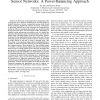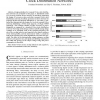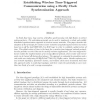250 search results - page 28 / 50 » A Case Study of Organizational Effects in a Distributed Sens... |
AUTONOMICS
2008
ACM
13 years 10 months ago
2008
ACM
A prominent functionality of a Wireless Sensor Network (WSN) is environmental monitoring. For this purpose the WSN creates a model for the real world by using abstractions to pars...
TON
2010
13 years 6 months ago
2010
—In this paper, we investigate the maximization of the coverage time for a clustered wireless sensor network (WSN) by optimal balancing of power consumption among cluster heads (...
COORDINATION
2009
Springer
14 years 9 months ago
2009
Springer
: Heterogeneous wireless sensor networks represent a challenging programming environment. Servilla addresses this by offering a new middleware framework that provides service provi...
ISCAS
2006
IEEE
14 years 2 months ago
2006
IEEE
Abstract—Design guidelines for resonant H-tree clock distribution networks are presented in this paper. A distributed model of a two-level resonant H-tree structure is described,...
WISES
2008
13 years 10 months ago
2008
In South-East Asia, huge swarms of fireflies synchronously emit light flashes to attract mating partners. The underlying principle can be used to implement a robust and scalable d...



